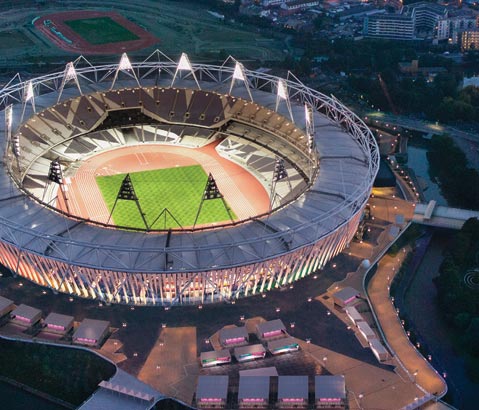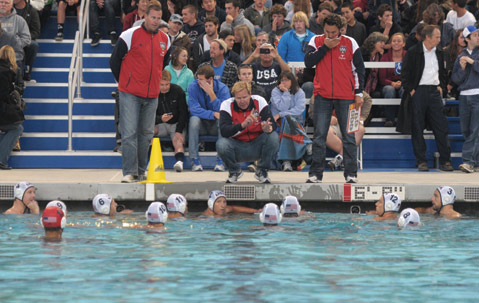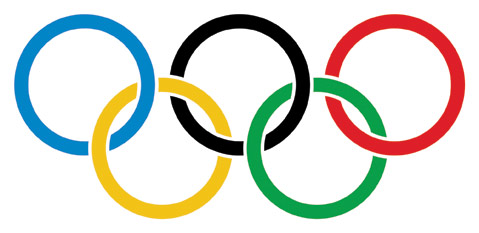Let the Games Begin
Olympic Memories and the Santa Barbarans Competing in London

Santa Barbarans in London
Perhaps hoping it will bring out the sun, organizers of the 2012 Summer Olympic Games have put a beach in the heart of London. The beach volleyball competition will take place on the grounds of the Horse Guards Parade, situated between the prime minister’s residence and Buckingham Palace. The changing of the guard is something that Todd Rogers does not want to see. Rogers and his playing partner Phil Dalhausser will be defending the championship they won four years ago in Beijing.
Kami Craig hopes to take one step higher on the podium. She earned a silver medal in 2008 with the U.S. women’s water polo team. They lost the championship match by one goal. Craig and most of her teammates have returned for a shot at the gold.
Rogers (San Marcos High) and Craig (Santa Barbara High) are continuing a tradition that began almost three decades ago with Karch Kiraly (SBHS) and Terry Schroeder (SMHS). In every Olympics since 1984, athletes from Santa Barbara have been impact players in volleyball or water polo, or both.
VOLLEYBALL: The rest of the world has been chipping away at the mystique of the Rogers-Dalhausser team. They have a way of coming back from serious deficits. Among the rivals that will try to drive a spike into their hearts are Brazil’s Alison Cerutti and Emanuel Rego, and fellow Americans Jake Gibb and Sean Rosenthal.
“There’s an edge in having been there, done that,” Rogers said. The UCSB graduate, dubbed “The Professor,” is regarded as the smartest player in the game. At the age of 38, and having undergone knee surgery last August, his focus has to be sharper than ever. Rogers’s mental fortitude meshes with the imposing presence of the 6’9” Dalhausser, known as the “Thin Beast.” The Florida native can turn matches around by going on a shot-blocking rampage.
Dalhausser refers to his partner as “Steady Eddie.” He pointed to this year’s first tournament, the Brasilia Open. “It was hot, high altitude, and every serve went to Todd,” Dalhausser said. Opponents understandably thought they could wear Rogers out if he had to pass, jump, and swing on every defensive possession. How did that work out? Rogers and Dalhausser won the title.
Karch Kiraly is volleyball’s most decorated Olympian, having won two gold medals with the U.S. indoor team (1984 and ’88) and the first beach gold in 1996. He was an NBC commentator at Beijing, where American volleyballers had unprecedented success — three golds (men’s indoor, men’s and women’s beach) and a silver (women’s indoor).
Now, Kiraly is trying to help the U.S. women’s team. He signed on as their assistant coach in 2009, joining Hugh McCutcheon, who had been coaching the men’s team. “Our athletes have to compete with absolute ferocity,” said Kiraly, who was known for doing just that. “People bring their best against the U.S.A.”
The U.S. roster includes fiery setter Lindsey Berg, whose parents — Dennis, a former UCSB player, and Tina Berg — live in Santa Barbara, and Destinee Hooker, a talented Texan of whom Kiraly said, “She does things most people, men or women, are incapable of doing.”
WATER POLO: Terry Schroeder made the transition from legendary player to national coach before the Beijing Olympics, where he led the U.S. men to their first medal finish in 20 years. Of course, it was silver — the same color that he won twice as the team’s captain.
“Terry has been on a lifelong journey in a quest for a gold medal,” observed Wolf Wigo, the UCSB coach who will be working for NBC in London.
International men’s water polo is loaded with heavyweight teams. In group play, the Americans will face three top contenders — Montenegro, Serbia, and Hungary, the three-time defending champion. “They can’t overlook Romania in their second game,” Wigo said. “That’s a dangerous one.” Led by four-time Olympian Tony Azevedo, the U.S. team is very experienced, but for Schroeder’s journey to reach fulfillment, Wigo said, “It will take luck and clutch play.”
Wigo tagged the U.S. women as “the definite favorite” to win a gold medal after going silver-bronze-silver in the first three Olympics to feature women’s water polo. It will be the fourth time around for two players, Brenda Villa and Heather Petri, and Craig figures to be a strong force in her second Olympics. “Kami’s doing great,” Wigo said of the 25-year-old, who joined the team a year out of high school. “She’s at the peak of her athletic ability.”
Craig said, “I was the youngest player on the team [in Beijing], and I was a little nervous, a little timid. Now I know when to be focused and when to enjoy the moments. We’ve done a good job being confident as well as respecting our opponents. Our attitude is that anyone can take you out. There will be a lot of one-goal and two-goal games.”
The Americans qualified for London by winning the Pan-American title last year in a harrowing match against Canada. Craig scored a late goal to tie the score, 8-8, sending it into overtime. It went to a sudden-death penalty shootout, and both sides kept scoring until the U.S. finally prevailed by a score of 27-26. “I was having heart attacks with every shot,” Craig said.
There will be a changing of the guard in women’s water polo. The Netherlands, 9-8 winners over the U.S. in the 2008 gold-medal match, did not qualify for London. But past champions Australia (2000) and Italy (2004) will be there.

What to Watch in London
Here is a chronological listing of a dozen things to watch for in the London Olympics. It reflects my bias in favor of athletics (as the British call track-and-field).
Opening ceremonies (July 27): Sebastian Coe and Daley Thompson were notable British champions in the 1980 and ’84 Games, but there is no better sportsman to take the starring role in the ceremonies than the fourth-place finisher in the 1,500 meters in 1952. He peaked in 1954, a non-Olympic year, and retired soon after to begin a distinguished medical career. A chap by the name of Roger Bannister.
Men’s 4×100 swim relay (July 29): Four years ago, Jason Lezak’s torrid anchor lap stunned the favored French team at Beijing. This time, Australia is aiming to take down Michael Phelps and company. Lezak, at 36 the old man of the pool, may swim only in a preliminary heat, but that would put him in contention for his eighth Olympic medal.
Women’s gymnastics (July 31): The U.S. tries to nail down its first team championship since Kerri Strug’s painfully heroic landing on an injured ankle in 1996.
Women’s heptathlon (Aug. 3-4): Jessica Ennis hopes to become Great Britain’s third queen of all-around athletics, after Mary Peters (1972) and Denise Lewis (2000). Ennis posted a score of 6,906 in May.
Men’s 400-meter dash (Aug. 4-6): South Africa’s Oscar Pistorius, the “Blade Runner,” will compete with carbon-fiber wands where his lower legs, amputated when he was an infant, used to be. More power to him — any sprinter would rather have calves. Another runner with a story is Bryshon Nellum, who made the U.S. team four years after he took three gunshots in his legs near the USC campus.
Men’s 100 (Final Aug. 5): Usain Bolt, the Beijing record-blaster, came up short against Yohan Blake in the Jamaican trials. Tyson Gay and Justin Gatlin of the U.S. will try to break them up.
Women’s 100 hurdles (Final Aug. 7): Lolo Jones gets all the attention because of her misfortune four years ago (she stumbled over the next-to-last hurdle while leading), her beauty, and her self-professed virginity. But defending Olympic champion Dawn Harper dusted her at the U.S. trials, and Australia’s Sally Pearson is the 2011 world champion.
Women’s beach volleyball (Final Aug. 8): After they won their second gold medal in 2008, Misty May-Treanor ruptured an Achilles tendon in “Dancing with the Stars,” and Kerri Walsh gave birth to two sons. A triple crown would be a pleasant surprise.
Women’s 200 (Final Aug. 8): Allyson Felix, a three-time world champion, seeks her first Olympic gold in the half-lap sprint. Sanya Richards-Ross will chase her in the second half of a daunting 400-200 double.
August 9: Rent another TV. Here is a smattering of what’s happening on this Thursday: The men’s beach volleyball final. The women’s water polo final. The women’s soccer final (can it top the drama of last year’s U.S. matches against Brazil and Japan?). The men’s 200 (will Bolt double-double again?) and 800 (there may be no better all-around runner than Kenya’s David Rudisha, whose 1:41.01 record is a two-lap sprint). And, to top it off, new world record holder Ashton Eaton and compatriot Trey Hardee will be grinding to the finish of the decathlon.
Men’s 4×100 relay (Final Aug. 11): This is America’s contribution to Olympic bloopers. A sloppy handoff cost the U.S. speedsters a gold medal in 2004, and they dropped the baton in the first round in 2008. Even with perfect passing, they might not beat the Jamaicans.
Men’s marathon and closing ceremony (Aug. 12): The marathon owes its peculiar distance to the Brits, who tacked 385 yards onto the specified 26-mile route at the 1908 London Olympics so the runners would finish directly in front of the queen’s royal box. The distance stuck.

The symbolic Olympic rings appear in five colors, at least one of which is on the flag of every nation in the world. To me, they represent the five foreign cities to which I’ve traveled to attend the Summer Olympic Games.
Black — Munich (1972): Bavaria put on a bright, happy face to counter the images of the 1936 Berlin Games when the Nazi war machine was gearing up. It was my first Olympics, and my idealistic mindset was reinforced by the men’s javelin competition. Soviet champion Janis Lusis, who had watched the execution of his father by German soldiers at age six, came up an inch short of victory on his last throw. The winner was Germany’s Klaus Wolfermann. The men embraced warmly and raised each other’s arms in friendship. But two days later, the Olympic movement had its 9/11 — the deaths of 11 Israelis at the hands of Black September terrorists.
Red — Montreal (1976): It was Canada’s misfortune to follow Munich and inherit new security concerns, which, along with construction costs, plunged these Games deep into the red. The performances were excellent. The Cuban runner Alberto Juantorena lived up to his handle, “El Caballo,” as he powerfully raced to victory in both the 400 and 800. Nadia Comaneci brought perfection to gymnastics; Bruce Jenner seized the moment and finished his record decathlon with a flourish.
Yellow — Barcelona (1992): The sun was blazing every morning as I made the climb up to Montjuïc, the Olympic site overlooking this bustling city of artistic splendor. An incendiary arrow ignited the Olympic flame. These Games left a glowing memory, especially of the night when all the people of Catalonia seemed to be jamming the streets, honking horns, and waving flags after Fermín Cacho sprinted the last lap to win the 1,500-meter run. The Spaniards eked out a hard-fought win over the United States in the water polo semifinals, and, most buoyantly, Spain scored in the final minutes of the soccer final to defeat Poland, 2-1, at the iconic Camp Nou stadium.
Green — Sydney (2000): The image of Cathy Freeman resolutely circling the track in her green, hooded body suit remains indelible. She ran for her Aboriginal forebears, and she ran for Australia, as 112,000 spectators screamed with all their might during her 49-second journey to 400-meter gold. Chants of “Aussie Aussie Aussie, Oi Oi Oi” spontaneously rang out on the streets and in the metro rail cars throughout the Games. The decibels were beyond jet-engine levels inside the 18,000-seat swimming arena when Ian Thorpe overtook Gary Hall Jr. to end America’s record of never having lost a 4×100 freestyle relay. Jason Lezak, the UCSB graduate who was to create a sensation in the same relay eight years later, swam the third leg for the U.S.
Blue — Athens (2004): The Olympics returned to the ancient land of their birth, including the women’s and men’s marathons beginning in the town of Marathon. The Greeks quelled their argumentative ways and were gracious hosts. At the shore of the blue Aegean Sea, one of the newest Olympic sports, beach volleyball, attracted enthusiastic crowds. It was a memorable experience for Santa Barbara athletes Dax Holdren (beach volleyball), Brook Billings (indoor volleyball), Chris Segesman (men’s water polo), Adam Duvendeck (track cycling), and Thalia Munro (women’s water polo). Munro came home with a bronze medal.
The two Summer Olympics hosted by U.S. cities in my lifetime left different impressions.
Los Angeles (1984): Although marred by the absence of Soviet bloc countries in reprisal for the American-led boycott of Moscow in 1980, these Games pumped energy and goodwill into the Olympics. Thanks to stringent organization and thousands of volunteers, they made money. Two U.S. programs, led by young athletes from Santa Barbara, rose to international prominence — the men’s volleyball team, with Karch Kiraly, winning the first of two consecutive gold medals; and men’s water polo, anchored by Terry Schroeder, which went unbeaten in L.A. but took the silver medal because of a controversial tiebreaker rule. There was drama on the track, where Mary Decker fell down at the heels of Zola Budd, and the dazed Gabriele Andersen-Schiess staggered into the Coliseum and willed herself to finish the first women’s marathon, won by the supremely fit Joan Benoit.
Atlanta (1996): The Games got off to an inspiring start when Muhammad Ali lit the flame, but they slumped into an excess of commercialism and organizational snafus. I rode a bus that was supposed to take me to the rowing competition; it wound up hopelessly lost in an Atlanta suburb. A domestic terrorist bombed the centennial Olympic Park. Two sports made spectacular debuts — women’s soccer, with a 2-1 victory by the U.S. over China that previewed the 1999 World Cup; and beach volleyball, which produced an epic showdown. Karch Kiraly and Kent Steffes, down 12-8 (before rally scoring), came back to win their grudge match over Sinjin Smith and Carl Henkel, 17-15. Then there was Michael Johnson’s 19.32 in the 200 meters, which seemed it would forever be the standard until Usain Bolt came along.



